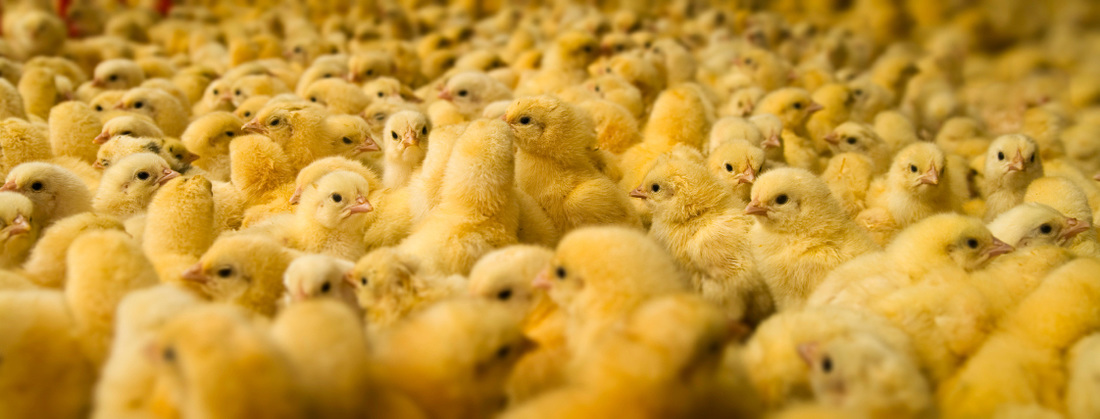|
A major shift in egg production is underfoot — although most consumers probably haven't noticed.
Also read, Food trucks in Montreal face too many regulatory roadblocks. In the coming years, the egg production industry is aiming to phase out the practice of killing male chicks after they're born, and new Canadian technology may help do that. Killing male chicks, or chick culling, is standard practice because they can't lay eggs, and the type of chicken used by the meat industry is different from that used by egg producers. Chicks gassed, suffocated, ground up Chick culling is routine even in parts of the egg industry where more humane techniques have been adopted. Although a carton of eggs may have a seemingly-humane label like "free range" or "organic," chick culling was almost certainly part of the production cycle. And even if you don't have a soft spot for chirping baby chickens, the methods of chick culling can make for squeamish images. Male chicks are typically gassed, asphyxiated or sent by conveyor belt to a grinder. Historically, these males would have been destined for the chicken meat market. But the practice of chick culling has been common for decades, ever since fast-growing breeds became standard in the meat-producing industry. Now, that's set to change. Chick sex could be determined before hatching Harry Pelissero is the general manager of Egg Farmers of Ontario, which has been working with Michael Ngadi, a professor of bioresource engineering at McGill University, to develop a machine that selects female eggs before they're hatched. "It's kind of like when you candle eggs," Pelissero said, referring to a traditional practice used to determine if an egg is fertilized by holding it in front of a candle or lamp to look for blood vessels. "There is a light that passes through [the egg], and we're able to determine whether it's male or female." The eggs are examined almost as soon as they are laid, Ngadi told CBC News. A technique called hyperspectral imaging, allows the eggs to be viewed under different colours of light, including colours we can't see, such as infrared. When viewed through the eggshell under infrared light, male and female embryos have a different distribution of cells. "We're now at a stage where we're going to take it into commercialization and work on speed," Pelissero said. "And that we hope to have done by spring of next year, and then we can start taking some orders." Pelissero said there's interest in the technology in both Europe and North America. It may seem like an obvious solution to a longstanding, and controversial, practice in the egg industry. But until now, no technology was efficient and accurate enough to take over. Surprisingly, hatching millions of baby chickens and killing half of them has been the most efficient practice in the egg industry to this point. Male eggs could be sold Pelissero said the new technology developed at McGill allows hatcheries to identify the gender of a fertilized egg before it enters the incubator. That means to consumers, it looks like a normal supermarket egg. And those male eggs removed from hatcheries may in fact end up on your plate. Ngadi's technique was originally developed four or five years ago to distinguish between unfertilized and fertilized eggs. Egg Farmers of Ontario asked him if it could be expanded to include sex selection, and that proved to be possible. Pelissero said the next step is to get the technology to the point where it can sort through between 3,000 and 6,000 eggs an hour, in order to make it commercially viable. But he's encouraged by the potential. "It's non-invasive, it's pre-incubation, and the eggs that are identified as non-female will be able to be sold." U.S. industry group promises end to culling Now that technology is catching up, the biggest egg producers organization in the U.S. has committed to ditching chick culling within four years. The United Egg Producers represents 95 per cent of U.S. egg farmers. European associations are also committing to a similar shift. Last year, Germany's parliament voted down a proposal to ban chick culling, but did provide funding to study methods of chick sex selection there. Pelissero says the end of chick culling is around the corner. "According to my timeframe, I'd like to have something in a hatchery by either late fall or early spring, run it for three or four months, get the bugs out," he said. "I would think within the next two or three years, we can ensure that male chicks aren't hatched." The technology obviously solves one of the animal welfare problems in egg production. But the cost savings are another benefit. Pelissero says hatcheries will instantly double capacity in their incubators, because all the eggs going in will be female. They'll no longer have the need to sort live chicks — and no need to deal with the gruesome task of killing the males. Source Khalil Akhtar, CBC News
0 Comments
Leave a Reply. |
Advertisement
News & Updates
Stay informed with the latest news around foodservice, agriculture and other related food news. Advertisement Opportunities
|


 RSS Feed
RSS Feed


